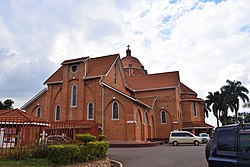| Namirembe Cathedral | |
|---|---|
 Aerial View of Namirembe Cathedral in Uganda (2022) | |
| Religion | |
| Affiliation | Anglican Communion |
| District | Kampala, Uganda |
| Ecclesiastical or organizational status | Major cathedral |
| Leadership | Bishop - The Rt. Rev. Moses Banja Dean – The Very Rev. Canon Jonathan Kisawuzi Ssalongo Vicar - Rev. George William Kyeyune Asst. Vicar - Rev. Keziah Nakazzi Curate - Rev. Samuel Muwonge |
| Year consecrated | 1919 |
| Location | |
| Location | Namirembe, Kampala, Uganda |
 | |
| Geographic coordinates | 0°18′54″N32°33′35″E / 0.31500°N 32.55972°E |
| Architecture | |
| Groundbreaking | 1915 |
| Completed | 1919 |
| Website | |
| https://namirembecathedral.org/ | |
Saint Paul's Cathedral Namirembe, commonly and locally (Uganda) referred to as Namirembe Cathedral , is the oldest Anglican cathedral in Uganda. It serves as the provincial cathedral of the Anglican Church of Uganda and the diocesan cathedral for Namirembe Diocese, the first diocese to be founded in the Church of Uganda province in 1890. [1] Between 1919 and 1967, the Cathedral served as the provincial cathedral of the Church of Uganda, Anglican Communion. In the 1960s, the headquarters of the Church of Uganda moved to All Saints Church in Nakasero then moved back to Namirembe later. [2]

